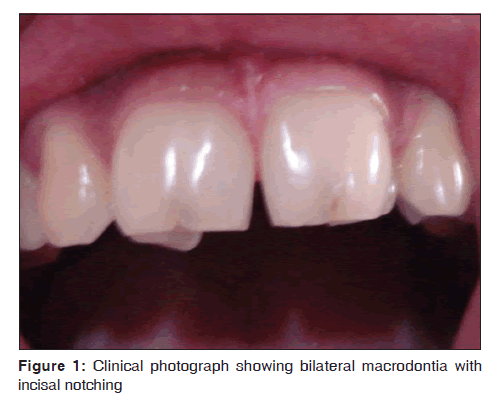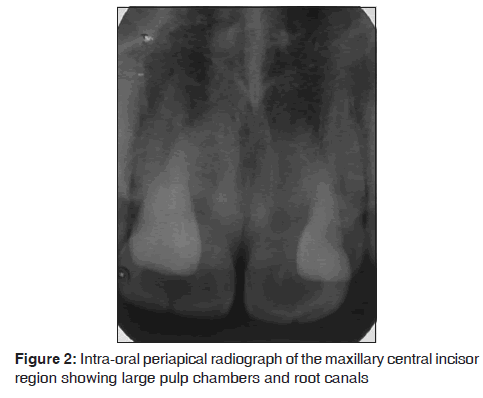Twin Tooth on Either Side: A Case Report of Bilateral Gemination
- *Corresponding Author:
- Dr. Prasanna Kumar Rao
Yenepoya Dental College, Yenepoya University, Nithyananda Nagar Post, Deralakatte, Mangalore, Karnataka, India
E-mail: drjpkrao@gmail.com
Abstract
Gemination is an anomaly caused by a single tooth germ that attempted to divide during its development, resulting in a bifid crown. They are found more frequently in the primary than in the permanent dentition unilaterally, but bilateral gemination is very rare. It is caused by complex interactions among a variety of genetic and environmental factors. This developmental anomaly may cause clinical problems including esthetic impairment, periodontal problems, caries, and tooth crowding. Here, we report a unique case of bilateral gemination of permanent maxillary central incisors.
Keywords
Bifid crown, Bilateral gemination, Double teeth, Twin tooth
Introduction
Tooth gemination is defined as single enlarged tooth or joined tooth wherein the tooth count is normal when the anomalous tooth is counted as one. It is an attempt of a single tooth bud to divide. A tooth with a bifid crown clinically gives an appearance of double teeth with a common root canal or rarely has separate canals. Gemination and fusion are clinically appears similar, and they can be differentiated by assessing the number of teeth in the dentition.[1-4]
The prevalence rate of unilateral gemination is 0.5% in deciduous teeth and 0.1% in permanent dentition.[1] Prevalence of bilateral cases is 0.01% to 0.04% in primary dentition and only 0.02% to 0.05% in permanent dentition.[5]
Case Report
A 25-year-old male patient reported to our clinic with the complaint of decay in the right back region of the upper jaw. On clinical examination, dentinal caries was observed on the occlusal surface of upper right first molar. Macrodontia was observed in relation to the maxillary central incisors. The central incisors were larger in the mesiodistal dimension. There was a notching present in relation to the incisal edge of the macrodonts. On the right central incisor, the notch continued cervically as a shallow groove [Figure 1], whereas on the left central incisor, the groove continued only till the middle third of the crown. The lateral incisors were placed palatally. The patient had normal compliment of teeth for his age. The intra-oral periapical radiograph of the maxillary anterior region revealed large crowns of the central incisors bilaterally. A radiolucent notch was observed in relation to the incisal edges of the central incisors [Figure 2]. Relatively large pulp chambers and root canals were observed in relation to the central incisors, which suggestive of bilateral gemination.
Since the patient was not concerned about the esthetic problems due to macrodontia, only composite restoration in relation to the right maxillary first molar was done.
Discussion
A disorder of growth or development in the anatomical structures that results in anything different from normal is called anomaly.[6] An attempt of the division of a developing tooth bud resulting in an incomplete formation of two teeth is called as gemination. Its crown shows a low deep groove from incisal to gingival third. Radiographically, there is only one root and usually only one root canal. In gemination, a normal number of teeth are maintained. This anomaly has a large bifid crown, which usually found as an isolated trait.[7] Complete Case history, clinical examination, and radiographic investigation can provide the information required for the diagnosis of such abnormalities.[8] Our case also shows the above clinical and radiographical features. The palatal view of clinical image should have been taken, but this was not done.
Other terminologies used to describe gemination are double teeth, double formations, joined teeth, fused teeth, or dental twinning.[9] The etiology of geminated teeth remains unknown, but nutritional deficiency, endocrine influences, and infectious/ inflammatory processes, excessive ingestion of medicines, hereditary or congenital diseases, and local traumas and by ionizing radiation is also considered.[4,5] Gemination is most commonly seen in maxillary primary incisors but is rare in permanent dentition.[7] The teeth involved in our case were permanent maxillary central incisors.
The clinical problems, particularly if the anterior teeth are involved, vary from tooth malalignment, spacing problems, arch asymmetry, esthetic problems, and periodontal involvement and impeded the eruption of the adjacent tooth.[7] Presence of deep groove in some cases of gemination makes them susceptible to caries and periodontal diseases.[10,11] If these defects are very deep and extend to gingival third, the chances of bacterial plaque accumulation in this area are high. Strict oral hygiene practice is advised to maintain periodontal health.[5] In our patient, the anomaly caused decrease in maxillary arch space, resulting in palatally erupted maxillary lateral incisors. Despite a shallow buccal groove being present, no serious periodontal disease was evident.
In case of permanent dentition, treatment of choice will be determined by the patients need. The endodontic treatment followed by surgical division of crown has also reported. In some cases, extraction with prosthetic replacement is advised and also reducing tooth structure mesiodistally and placing a composite restoration to give the tooth a normal appearance.[12] Our patient was not concerned about the esthetic problems due to macrodontia; therefore, other restoration was carried out.
Conclusion
The dental gemination is a morphological alteration that sometimes is confused with fusion but confirmed by thorough clinical examination and radiographic investigation. Bilateral gemination is not a usual condition, but it is one of the important dental anomalies. Recognizing the condition will help in planning the appropriate treatment. A geminated maxillary central incisor requires complex multidisciplinary treatment to preserve its health and restore esthetics.Source of Support: Nil.
Conflict of Interest: None declared.
References
- Neville BW, Damm D, Allen C, Bouquot J. Oral and Maxillofacial Pathology. 2nd ed. New Delhi: Elsevier; 2004. p. 78.
- Altug-Atac AT, Erdem D. Prevalence and distribution of dental anomalies in orthodontic patients. Am J Orthod Dentofacial Orthop 2007;131:510-4.
- Karaçay S, Gurton U, Olmez H, Koymen G. Multidisciplinary treatment of “twinned” permanent teeth: Two case reports. J Dent Child (Chic) 2004;71:80-6.
- Santos KS, Lins CC, Almeida-Gomes F, Travassos RM, Santos RA. Anatomical aspects of permanent geminate superior central incisives. Int J Morphol 2009;27:515-7.
- Türkaslan S, Gökçe HS, Dalkız M. Esthetic rehabilitation of bilateral geminated teeth: A case report. Eur J Dent 2007;7:188-91.
- Alvares LC, Tavano O. Aspectos radiográficos das anomalias dentárias e maxilares. In: Freitas A, Rosa JE, Souza IF, editors. Radiografia Odontológica. 5th ed.. São Paulo, Artes Médicas; 2000. p. 447-62.
- Hattab FN, Hazza’a AM. An unusual case of talon cusp on geminated tooth. J Can Dent Assoc 2001;67:263-6.
- Milano M, Seybold SV, McCandless G, Cammarata R. Bilateral fusion of the mandibular primary incisors: Report of case. ASDC J Dent Child 1999;66:280-2.
- Guimarães Cabral LA, Firoozmand LM, Dias Almeida J. Double teeth in primary dentition: Report of two clinical cases. Med Oral Patol Oral Cir Bucal 2008;13:E77-80.
- Aguiló L, Gandia JL, Cibrian R, Catala M. Primary double teeth. A retrospective clinical study of their morphological characteristics and associated anomalies. Int J Paediatr Dent 1999;9:175-83.
- Blank BS, Ogg RR, Levy AR. A fused central incisor. Periodontal considerations in comprehensive treatment. J Periodontol 1985;56:21-4.
- Agnihotri A, Marwah N, Goel M. Geminated maxillary lateral incisor with Talon’s Cusp-A rare case report. J Oral Health Comm Dent 2007;1:40-2.






 The Annals of Medical and Health Sciences Research is a monthly multidisciplinary medical journal.
The Annals of Medical and Health Sciences Research is a monthly multidisciplinary medical journal.